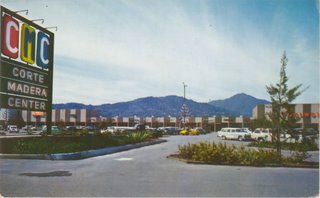Town Center Corte Madera, originally known as Corte Madera Center, officially opened its doors on July 17, 1958, bringing the suburban shopping boom to Marin County. Just a few months later, JCPenney joined the growing lineup, followed by Montgomery Ward, which opened on March 16, 1960.
Like many mid-century shopping centers across the Bay Area, Corte Madera Center arrived with ambition and architectural flair. Designed for easy access just off U.S. Route 101, it featured large department stores alongside specialty retailers, a format that would become a standard in American retail.
Today, Town Center Corte Madera stands as a revitalized open-air shopping hub, blending its historic roots with modern lifestyle and community-focused retail.
A vintage postcard glimpse of Town Center Corte Madera
One of the best glimpses we have of the center’s early years is a 1960s postcard, most likely taken not long after Montgomery Ward arrived. The scene is carefully staged—photographer Mike Roberts, known for his iconic mall postcards, ensured Mount Tamalpais and the rolling hills of Marin were front and center.
 |
| A vintage postcard view of Corte Madera Center in the early 1960s, with Mt. Tamalpais in the background and colorized storefronts of Woolworth’s and Thrifty taking center stage. |
The postcard’s back reads:
"Corte Madera Center, Marin County, California. This extensive Shopping Area (too big for a single picture) of large stores and specialty shops is easily accessible and adjoins U.S. #101."
And while the photo feels natural, there’s some unmistakable colorization magic at play—Woolworth’s and Thrifty glow a little too brightly to be real. Still, for anyone who remembers Thrifty’s legendary 15¢ ice cream cones, we’ll allow a little photographic exaggeration.
From Corte Madera Center to Town Center
Over the years, the center evolved with the times. After Montgomery Ward closed unexpectedly, a major remodel in 1985 brought in new architecture, a fresh mix of tenants, and a revitalized name: Town Center Corte Madera. Though modernized, many original elements remain—open-air walkways, clear sightlines to the hills, and a central role in the community.
The mid-2000s brought its newest chapter, including the arrival of Barnes & Noble, which stirred passionate local discussion due to its proximity to longtime indie bookstore Book Passage. It's a reminder that Corte Madera Center—now over six decades old—still holds deep significance for the community.
The legacy lives on
For those who grew up in Marin, Corte Madera Center was more than a shopping stop. It was a backdrop to everyday life. A place where memories were made, from back-to-school shoes at JCPenney to browsing record bins under fluorescent lights.
This postcard reminds us of where it all began—and how much of that spirit still lingers.
Related posts
The history of Northgate Mall in San Rafael — the 2008 renovation
Comments
Penneys was not the only anchor. Montgomery Ward took up the west side of the mall in a building that is mostly Safeway now. So you had Penneys, Wards, Woolworths, Grants, Thrifty....IN MARIN COUNTY? I tell you, if any Bay Area mall has done a complete 180 in its format, it's this one.
But it didn't happen overnight. If I recall, this mall struggled a bit after it was remodeled, probably due to The Village across 101. In fact, I think they had a Goodwill store there for awhile, possibly in the old Penney building which is now Container Store.
I believe the Corte Madera Penneys(along with Alameda and Daly City)were the first Bay Area stores in a traditional mall setting, though there were others before that in strip center formats. I'm also certain they were the last Bay Area stores built that just sold apparel and soft goods.
The Corte Madera JC Penney would add a second floor in the 80's and double its size, but even after that it was still not considered a "full-line" store.
The shift in shopping center design has become profound -- to the point where entire small "downtowns" or similarly themed shopping areas are being recreated for shopping in, (some refer to them as "lifestyle centers"). Ironically, places like Irvine Spectrum and Victoria Gardens are still significantly detached from the surrounding areas a traditional shopping district would connect with. In stead of the Taumbman-style super regional mall in a sea of parking, one now has a quaint shopping district in a sea of parking.